
J. G. Freyer (Potsdam, c.1805)

A. F. Piering (Berlin, c.1815–20)
There were many centers of flute making in Germany, and many types of simple system flutes of instruments made over the century. Our survey cannot be complete but is directed in large part by the instruments in the author's collection.
We start with two typical examples of Prussian eight-keyed flutes from Beethoven's lifetime.


A. F. Piering (Berlin, c.1815–20)
(A one-key flute, by Griesling & Schlott of Berlin, made at about the same time as these eight-key flutes can be seen on the page about classical flutes. It has a similar look and playing qualities.)
J. G. Freyer's father, C. F. Freyer, had collaborated with Quantz to build flutes for Frederick the Great. (The silver embouchure bushing on the Freyer is probably a repair. The foot joint on the Freyer is unstamped; see the page on classical flutes for a photo of the Freyer in a period case.)
The two flutes are similar in design. Both have eight keys and the G# key on the lower center. The finger hole placement and other dimensions are almost identical. But the Piering is later than the Freyer as can be inferred from the shapes of the keys, and the Piering is slightly louder and brighter in tone. The keys on the Piering are more 'modern', being smoother and less ornate, without the decorative touches.
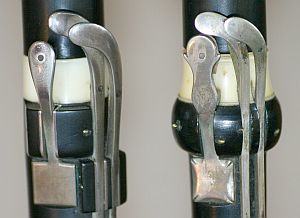
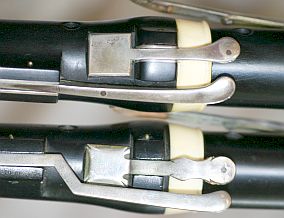
Both flutes originally had three-piece corps de rechange. The Piering survives only with center joint number 2. The silver linings to the wooden blocks on the Piering are not original, but part of a restoration.
The following flute by Braun is typical of the early 19th century Mannheim style.

The keys are mounted in saddles attached to the wood with screws. The Braun is lighter than the previous flutes, with thinner walls, somewhat like French flutes. I like to imagine that one can detect from the look, feel, and playing qualities (including easy high notes) of the Braun flute that Mannheim is much closer to France than is Berlin, without looking at a map.
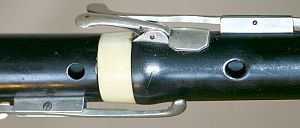
Like the Prussian flutes, the flute has no tuning head but a three-center corps de rechange. Curiously, there is no long C key on the longest center. The pitches are approximately A=435, A=440, and A=446.
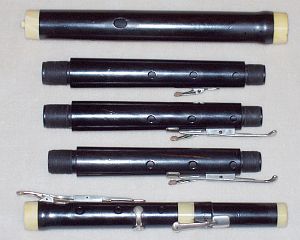
The second holes of the three centers can be seen below. The shortest joint (A=446) is on the left; it has received by far the most use, and the holes are worn. The A=435 joint on the right, on the other hand, is in like-new condition and was possibly never played.

A flute by Streitwolf has a B-foot but still retains the four piece construction, so the long b key is attached only on the foot (instead if pivoting on a pin higher up, near hole 4, as on later flutes) and the leverage is a bit awkward.

A distinctive feature on the Streitwolf is the elongated, rectangular embouchure. The flute on the left is the Streitwolf; the one on the right is a Liebel from Dresden from about the same time.
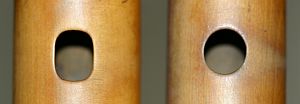
Streitwolf provided duplicate keys that control the same holes. This is not unusual for F and Bb, but the small lever for the left hand thumb (under the flute) that raises the long C key is not common.
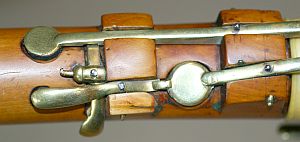
The interesting nine-key flute below is from the collection of Harry Bower. It is stamped G. Hartmann / Hamburg, and presumably made before his death in 1835. This is an early example of what would become the most common construction for better German simple system flutes: three sections, the head joint including a tuning barrel, the lower section with the right hand finger holes and a B-foot, and the G# key on the middle section with the left hand finger holes. The touch of the c'# key is given to LH4 on the Hartmann, however, and this would not be part of the standard construction, which would give the b key to LH4—see below.

The Hartmann is also an early example of a German flute with cupped keys, rather than flat flaps for leathers, and an early example of the use of nickel-silver for keys, rather than silver or brass.
The seven-key flute by B. Pentenrieder below has a common shape for Munich flutes, completely straight except for the narrow rings and small wooden blocks for the keys. We will have more to say about Pentenrieder's innovations elsewhere. I know of a number of other Munich flutes with a C#-foot. I often imagine that the low C# key was included more for the sake of an alternate fingering for c''# and other useful fingerings than for the low c'# itself.

Inexpensive (but not necessarily badly made) German flutes may have horn mounts. These are dark; sometimes they have a grain, and at other times, may be smooth and almost look like black plastic.

Below are two midcentury flutes with the mature German form (three sections with tuning head). At first, cupped keys were still mounted in integral wooden blocks, as on these flutes, but post mounting would become more common over the period 1850 to 1870 or so (depending on location).


9-key flute by A. Euler (Frankfurt, c.1860)
Below are four late (circa 1870–1930) German simple system flutes, with between 11 and 13 keys. The basic German simple system flute did not change dramatically in this period, and it is often difficult to accurately estimate the date of an instrument of this type, especially if anonymous. However, one helpful clue in the case of the top two instruments is that they have what I believe to be black bakelite rollers on the touches of the low C# and C keys; this material, one of the first plastics, was patented and produced starting about 1910.

The Euler and the Hammig are very fine players; the others, in their current conditions with possible leaks, have serious problems (poor response, tone quality, and intonation in the first octaves). But the Euler is very bright, while the sturdy Hammig is quite a bit louder with more body, and is warmer sounding. The difference in timbre is in part due to the pitches. The Euler is at "high pitch" and plays at A=450 or so, while the Hammig is at "low pitch" of A=435 (diapason normal).
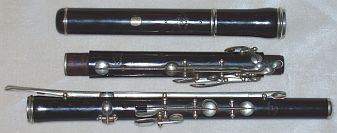
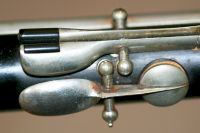
The production of musical instruments has been important in the area including Markneukirchen in the southeastern Vogtland since the 17th century. A huge number of late 19C/early 20C flutes were made there, many of which were exported. C.f. the c.1895 catalog of the firm of A. & G. Klemm.
The most usual form of an 11-key German flute is described on the pages on 5, 8, and 11-key flutes and 19th century simple system flutes, I. The twelfth key on the Hammig is a second key for G# for the left hand thumb, which can be seen in the photo above as the key most protruding beneath the center joint. (In addition to these, the Hüller also has a key for C#/B and other trills.)
U.S. trade laws required imported goods to be stamped with the name of the country of origin starting March 1, 1891. Thanks to Al Rice for pointing this out to me; click here for the reference. It is my understanding that the words "made in" were also required after about 1923. Below is the stamp of a flute (not shown here) by Kohlert. It reads "V. Kohlert Sons / makers / Graslitz" in gold, and below, "Austria / D". So this flute probably was probably made between 1890 and 1923. (The Bohemian town of Graslitz [Kraslice], which is not far from the Vogtland region of Germany, became part of Czechoslovakia by 1919, so we can be sure that the flute was made before then and thus probably before WW I.)
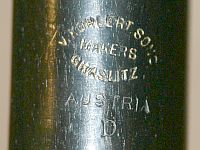
The stamp on the Hüller is shown below. There is a lyre and the initials GH inside an S. Below that is "made in Germany / C / L.P." As it is unlikely that the words "made in" would have been used before they were required, this allows us to date the instrument after 1923.
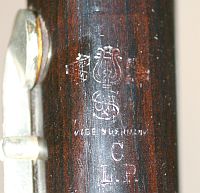
The "L.P." stamped on the Hüller also appears (in another place) on the Kohlert, and stands for "low pitch", A=435 in the case of these flutes. These two instruments are the same size and play at the same pitch. Yet one is stamped "D" and the other "C". Why? The Kohlert is stamped "D" because of the long-standing and perfectly logical idea that the standard size flute was "in D" because its basic scale was D major. The Hüller is stamped "C" because the way terms were used was changing and it became appropriate to say the flute was "in C" because it was the standard size and not a transposing instrument.
* * *
Two important German makers deserve a page of their own. They are (click on the photos to go to the pages) W. Liebel of Dresden [to be implemented soon]. . .

and H. F. Meyer of Hannover [working now].
